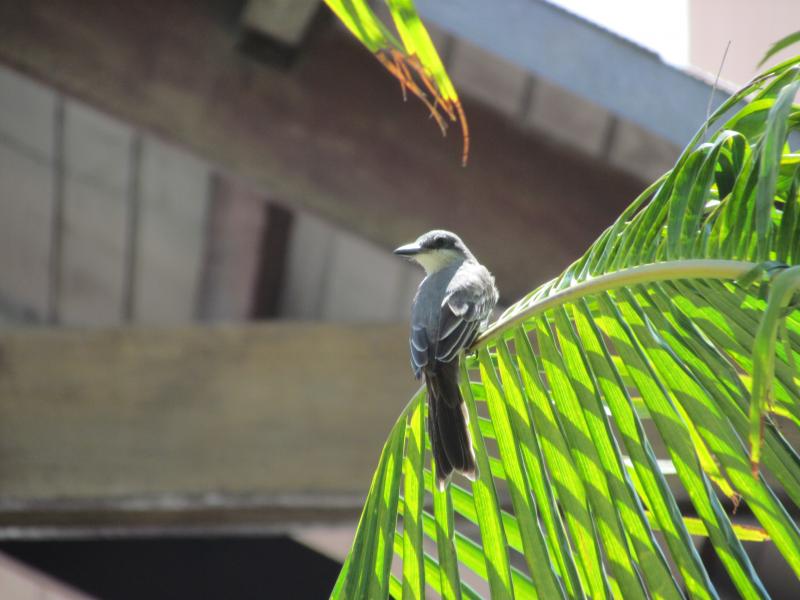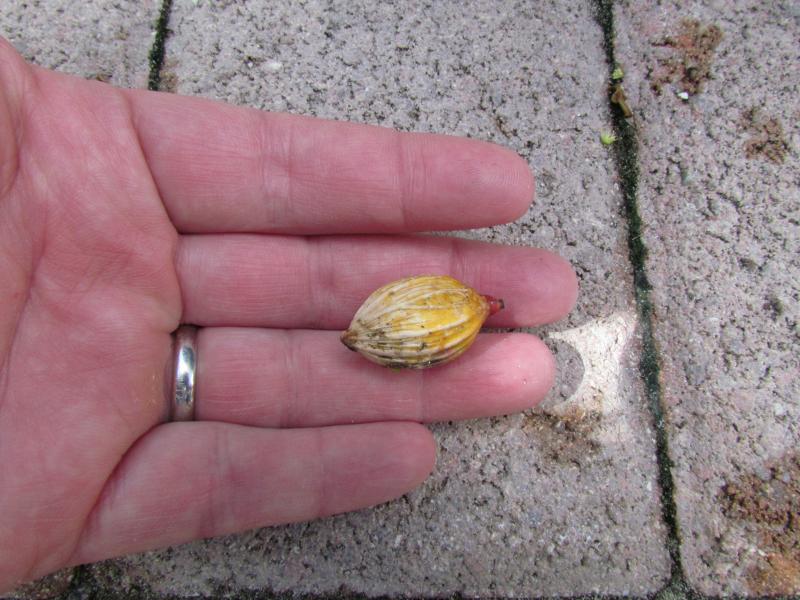Biddeford Pool Surprises Birders Yet Again
 A gray kingbird in a palm tree in the tropics (in this case, Aruba), which is where you expect to find them in their native range - far from the one discovered recently in Biddeford Pool, Maine. Courtesy of Jeff Wells
A gray kingbird in a palm tree in the tropics (in this case, Aruba), which is where you expect to find them in their native range - far from the one discovered recently in Biddeford Pool, Maine. Courtesy of Jeff Wells
 Believe or not, a gray kingbird coughed up this large pit from the even larger palm fruit it swallowed. Kingbirds and other flycatchers will eat fruits as well as insects. Courtesy of Jeff Wells
Believe or not, a gray kingbird coughed up this large pit from the even larger palm fruit it swallowed. Kingbirds and other flycatchers will eat fruits as well as insects. Courtesy of Jeff Wells
 A gray kingbird in a palm tree in the tropics (in this case, Aruba), which is where you expect to find them in their native range - far from the one discovered recently in Biddeford Pool, Maine. Courtesy of Jeff Wells
A gray kingbird in a palm tree in the tropics (in this case, Aruba), which is where you expect to find them in their native range - far from the one discovered recently in Biddeford Pool, Maine. Courtesy of Jeff Wells
 Believe or not, a gray kingbird coughed up this large pit from the even larger palm fruit it swallowed. Kingbirds and other flycatchers will eat fruits as well as insects. Courtesy of Jeff Wells
Believe or not, a gray kingbird coughed up this large pit from the even larger palm fruit it swallowed. Kingbirds and other flycatchers will eat fruits as well as insects. Courtesy of Jeff Wells
A few weeks ago we wrote about a rare ash-throated flycatcher that should have been in Mexico on its wintering range but that had appeared in Biddeford Pool. As we noted, there is pattern of rare flycatchers showing up in Maine (and other parts of the Northeast) in the late fall. We happened to mention in that column that the only two currently accepted records of gray kingbird for the state were both in the October-November period.
And then, amazingly, a gray kingbird was discovered on December 3 near Fortunes Rocks Beach in Biddeford Pool, only about two miles from where the ash-throated flycatcher had been found.
Gray kingbirds are a bird that is very characteristic of the Caribbean, although they do breed north into southern Florida (rarely and occasionally along Gulf Coast states and north to coastal North Carolina) and south into northern South America. Like many kingbirds, they are noisy, brash birds; they give a characteristic loud, exuberant “peecherry” that becomes a defining background noise in areas where they are common.
Like all kingbirds, gray kingbirds in their native range, are often conspicuous, sitting on the tops of palm trees and telephone poles. As their name suggests, they are light gray on the back, wings and head but have a darker mask through the eye and a rather large black bill.
Gray kingbirds are a favorite bird for us when we are visiting the island of Aruba. They are easy to see and hear including around the grounds of the resort hotels. We have often enjoyed watching their antics from the refreshing confines of the pool on a hot afternoon during visits to Aruba.
On one of our visits to Aruba, we noticed that the gray kingbirds were spending much of the time around the tops of some of the palm trees near the aforementioned pool. As we floated in the warm soothing waters, we pursued a relaxed study of the kingbirds. We were delightfully surprised to find that they were hovering over the small palm fruits, pulling them off and swallowing them whole. Later we even observed one regurgitating the hard pit of the palm fruit after the soft parts had been digested.
On Aruba, from our experience, the numbers of gray kingbirds have increased since the 1990s when they were to be found at only one or two locations on the island. Now they are quite widespread. Are they expanding or increasing more broadly? No one knows because there has been no long-term historical regional population monitoring of most species outside of the U.S. and Canada. Perhaps that will change with eBird and the growth of more Christmas Bird Counts in Latin America as well as other organized surveys.
At the time of this writing, the gray kingbird in Biddeford was showing the resilience of the species and was still surviving in this place so far from the tropical climes where the rest of its kind were residing at this time of year. There won’t be any palm fruits but perhaps it is finding some leftover rose hips, bayberries, or other fruits along with whatever insects it can glean from the wrack line that birders see it hovering around.
As birders get ready for the Christmas Bird Counts coming up later this month, we are all wondering what surprising bird will be next. Maybe you will be the one to spot it!
Jeffrey V. Wells, Ph.D., is a Fellow of the Cornell Lab of Ornithology and Vice President of Boreal Conservation for National Audubon. Dr. Wells is one of the nation's leading bird experts and conservation biologists and author of the “Birder’s Conservation Handbook.” His grandfather, the late John Chase, was a columnist for the Boothbay Register for many years. Allison Childs Wells, formerly of the Cornell Lab of Ornithology, is a senior director at the Natural Resources Council of Maine, a nonprofit membership organization working statewide to protect the nature of Maine. Both are widely published natural history writers and are the authors of the popular books, “Maine’s Favorite Birds” (Tilbury House) and “Birds of Aruba, Bonaire, and Curaçao: A Site and Field Guide,” (Cornell University Press).


























